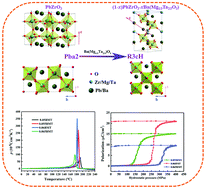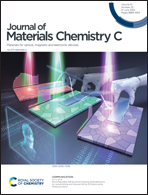Constructing ferroelectric–antiferroelectric phase boundary in PbZrO3-based ceramics for enhancing hydrostatic-pressure-induced depolarization performances significantly†
Abstract
The low depolarization-pressure and excellent temperature stability of ferroelectric materials are key to obtaining overspeed discharge in explosive energy conversion, which can be extensively applied in the areas of energy harvesting, modern defense, and mineral exploration. Despite the wide reporting of explosive energy conversion materials, the combination of low depolarization-pressure and great temperature stability is extremely rare. Here, a novel ferroelectric–antiferroelectric (FE–AFE) phase boundary has been proposed to achieve oxides with low depolarization-pressure and excellent temperature stability. A new dual system (1−x)PbZrO3–xBa(Mg1/3Ta2/3)O3 (xBMT) (x = 0.015–0.10) was designed by introducing Ba(Mg1/3Ta2/3)O3 to stabilize the FE ordering of PbZrO3. This work achieved easy realization of an FE–AFE phase transition under pressure through enhancing perovskite lattice ferroelectric (FE) distortion and decreasing the free energy difference between the FE and antiferroelectric (AFE) phases. The remanent polarization (Pr) can reach 29.80 μC cm−2 for a 0.65BMT ceramic that is located near the EF–AFE phase boundary region, and the 97% retained Pr can completely fade as the pressure increases from 225 MPa to 350 MPa. The depolarization temperature of the 0.06BMT ceramic is 182 °C and it exhibits perfect thermal stability. Its attractive pressure-induced depolarization behavior and excellent temperature stability show that 0.65BMT ceramic is a useful material for energy conversion applications. Moreover, the phase transformation sequences of orthorhombic AFE phase → rhombohedral FE phase are demonstrated by X-ray diffraction, transmission electron microscopy, and Raman scattering for xBMT ceramics. The effects of Ba(Mg1/3Ta2/3)O3 content on phase transitions, dielectric and ferroelectric properties, pressure-induced depolarization and temperature-driven depolarization properties of xBMT samples are studied systematically.



 Please wait while we load your content...
Please wait while we load your content...